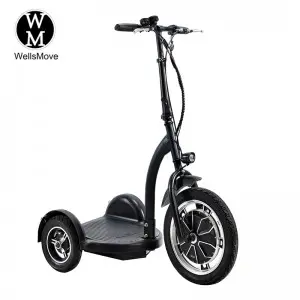What does the EU Medical Device Regulation have for mobility scooters?
The EU has very strict regulation of medical devices, especially with the implementation of the new Medical Device Regulation (MDR), the regulations on mobility aids such as mobility scooters are also clearer. The following are the main regulations for mobility scooters under the EU Medical Device Regulation:
1. Classification and Compliance
Manual wheelchairs, electric wheelchairs and mobility scooters are all classified as Class I medical devices according to Annex VIII Rules 1 and 13 of the EU Medical Device Regulation (MDR). This means that these products are considered low-risk products and manufacturers can declare that their products comply with regulatory requirements on their own.
2. Technical Documentation and CE Marking
Manufacturers must prepare technical documentation, including risk analysis and declaration of conformity, to prove that their products meet the essential requirements of the MDR. Once completed, manufacturers can apply for the CE mark, allowing their products to be sold on the EU market
3. European standards
Mobility scooters must comply with specific European standards, including but not limited to:
EN 12182: Specifies general requirements and test methods for assistive products and technical aids for people with disabilities
EN 12183: Specifies general requirements and test methods for manual wheelchairs
EN 12184: Specifies general requirements and test methods for electric or battery-powered wheelchairs, mobility scooters, and battery chargers
ISO 7176 series: Describes various test methods for wheelchairs and mobility scooters, including requirements and test methods for dimensions, mass and basic maneuvering space, maximum speed, and acceleration and deceleration
4. Performance and safety testing
Mobility scooters must pass a series of performance and safety tests, including mechanical and durability tests, electrical safety and electromagnetic compatibility (EMC) tests, etc.
5. Market supervision and oversight
The new MDR regulation strengthens market supervision and oversight of medical devices, including increasing the coordinated evaluation of cross-border clinical investigations, strengthening post-market regulatory requirements for manufacturers, and improving coordination mechanisms between EU countries
6. Patient safety and information transparency
The MDR regulation emphasizes patient safety and information transparency, requiring a unique device identification (UDI) system and a comprehensive EU medical device database (EUDAMED) to improve product traceability
7. Clinical evidence and market supervision
The MDR regulation also strengthens the rules of clinical evidence, including a multi-center clinical investigation authorization procedure coordinated across the EU, and strengthens market supervision requirements
In summary, the EU medical device regulations on mobility scooters involve product classification, compliance declarations, European standards that must be followed, performance and safety testing, market supervision and oversight, patient safety and information transparency, and clinical evidence and market supervision. These regulations are intended to ensure the safety and effectiveness of mobility assistive devices such as mobility scooters and protect the health and rights of consumers.
What performance and safety tests are required for mobility scooters?
As an auxiliary mobility device, the performance and safety testing of mobility scooters is key to ensure user safety and product compliance. According to the search results, the following are the main performance and safety tests that mobility scooters need to undergo:
Maximum driving speed test:
The maximum driving speed of a mobility scooter should not exceed 15 km/h. This test ensures that the mobility scooter is operating at a safe speed to reduce the risk of accidents.
Braking performance test:
Includes horizontal road braking and maximum safe slope braking tests to ensure that the scooter can effectively stop under different road conditions
Hill-holding performance and static stability test:
Tests the stability of the scooter on a slope to ensure that it does not slide when parked on a slope
Dynamic stability test:
Evaluates the stability of the scooter during driving, especially when turning or encountering uneven roads
Obstacle and ditch crossing test:
Tests the height and width of obstacles that the scooter can cross to evaluate its passability
Grade climbing ability test:
Evaluates the driving ability of the scooter on a certain slope
Minimum turning radius test:
Tests the ability of the scooter to turn in the smallest space, which is particularly important for operating in a narrow environment
Theoretical driving distance test:
Evaluates the distance that the scooter can travel after a single charge, which is particularly important for electric scooters
Power and control system test:
Includes control switch test, charger test, driving suppression test during charging, power on Control signal test, motor stall protection test, etc. to ensure the safety and reliability of the electrical system
Circuit protection test:
Test whether all wires and connections of the mobility scooter can be properly protected from overcurrent
Power consumption test:
Ensure that the power consumption of the mobility scooter does not exceed 15% of the manufacturer’s specified indicators
Parking brake fatigue strength test:
Test the effectiveness and stability of the parking brake after long-term use
Seat (back) cushion flame retardancy test:
Ensure that the seat (back) cushion of the mobility scooter does not produce progressive smoldering and flame burning during the test
Strength requirement test:
Includes static strength test, impact strength test and fatigue strength test to ensure the structural strength and durability of the mobility scooter
Climate requirement test:
After simulating rain, high temperature and low temperature tests, ensure that the mobility scooter can operate normally and meet relevant standards
These test items cover the performance, safety and durability of the mobility scooter, and are important steps to ensure that the mobility scooter complies with the EU MDR regulations and other relevant standards. Through these tests, manufacturers can ensure that their products meet all necessary safety and performance requirements before they are put on the market.
Post time: Jan-03-2025



